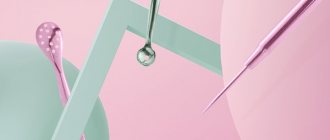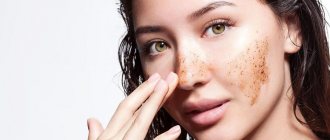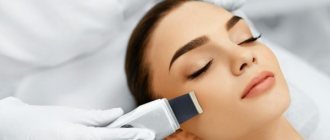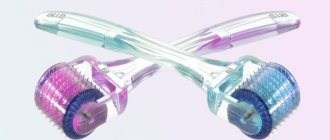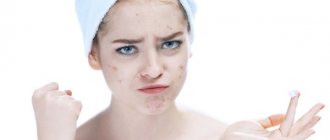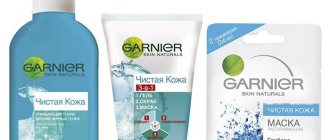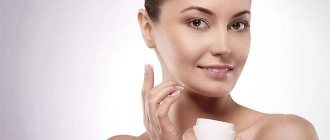Inflammation and uneven skin are the main enemies of health and beauty. They overshadow even impeccable features, nullifying natural beauty. However, today almost any problem can be eliminated by resorting to the professional help of a cosmetologist. In addition to accumulated experience, knowledge and special facial cleansing techniques, specialized tools are used. Using various techniques, the doctor will help you get rid of the annoying problem for a long time and will not leave even the slightest chance of relapse.
Mechanical facial cleansing procedure
Mechanical facial cleansing is a procedure for caring for problematic skin, but it is not capable of curing and completely eliminating problems. Thus, the process itself ensures deep cleansing of the epidermis from cosmetics, impurities, removal of blackheads, comedones, sebaceous plugs, exfoliation of the keratinized layer of cells.
Mechanical facial cleansing: indications and contraindications
Like every cosmetic procedure, skin cleansing has a number of features that are important to consider. First of all, this applies to recommendations on collecting anamnesis.
Indications for mechanical facial cleansing:
- oily or combination skin type;
- single acne;
- milia;
- comedones.
Contraindications:
- multiple inflamed and suppurating acne;
- pustular skin diseases (sycosis, furunculosis);
- herpetic rashes;
- clinical manifestations of dermatosis on the face, namely atopic dermatitis, eczema;
- epilepsy;
- bronchial asthma;
- severe form of hypertension;
- critical days.
Today, both instrumental and manual techniques are used. However, it is the first option that is recognized as the most effective, less traumatic, and also fast, which makes it more attractive for the patient and the doctor.
How to do mechanical facial cleansing correctly
The stages of skin cleansing necessarily include the following steps:
- cleaning the surface with foam or gel with antiseptic and anti-inflammatory components;
- skin toning;
- vaporization (at least 10 minutes). It is possible to apply a hot compress or cold hydrogenation;
- the skin is dried;
- observing all sterility requirements, cleanse the face, regularly wiping the skin with a disinfectant composition.
Procedures after mechanical facial cleansing include darsonvalization (3-5 minutes) and application of a mask with disinfectant, drying, anti-inflammatory and pigment-constricting properties.
Dermatillomania: causes
Dermatologists note that this problem is more common in people diagnosed with acne. In this case, picking at the skin may be associated with complexes and the desire to quickly get rid of the hated rashes. Unfortunately, it only gets worse.
Not the least role in this is played by filters, Photoshop, Instagram masks, which create in people a false idea of ideal skin not as healthy, but as completely smooth, devoid of any flaws, irregularities and not subject to age-related changes.
Some experts consider neurotic excoriation to be a type of obsessive-compulsive disorder. Others suggest distinguishing them according to this principle:
- if scratching the skin is a way to relieve anxiety, then it can be classified as an obsessive-compulsive behavior;
- if the action is associated with the very need to scratch the skin, then this should be considered dermatillomania.
Despite the fact that a person may be fully aware of the harm he is causing to himself, he cannot stop. Many compare the state to a trance.
There is also a hereditary connection. In addition to genetic predisposition, depression, eating disorder, dysmorphophobia, psychological trauma, chronic stress or other forms of addiction can provoke uncontrolled skin trauma.
Cosmetology instruments for mechanical facial cleansing
Cosmetic procedures are of great importance not only from an aesthetic point of view, but also from a medical point of view. This is why it is important to choose the right tools. A complete professional set of tools for carrying out a complex procedure and treating skin even in hard-to-reach or most delicate places includes many different tips, differing in the type of sharpening, size, and angle of inclination.
Cosmetic loop
Loop tips provide the safest and most atraumatic cleaning of pores from contaminants. The rod-shaped cosmetic loop has a noticeable effect on soft tissue, allowing you to quickly and effectively cleanse the skin. Mechanical facial cleansing with a flat-shaped loop has a more gentle effect due to the increased contact area.
Spoon Uno
The Uno spoon is used to clean the face using tangential, scraping movements. A subspecies with many small holes in the working area is also called “skimmer” or “strainer.” Passing over the skin, it removes the stratum corneum and removes excess secretions of the sebaceous glands. The working area is made in the shape of a circle or oval to ensure painlessness and eliminate the risk of injury to the patient.
The acne squeezer is made with 1 hole and is intended for targeted impact on problem areas, namely for the removal of deep and closed comedones. It is placed perpendicular to the surface of the skin and pressed
Cosmetology needle (Vidal needle)
This tool has several variations, differing in the shape of the tip, but they are united by ultra-sharp sharpening. A classic cosmetology needle is used as a pore expander to enlarge and puncture the mouth of the sebaceous duct, which makes cleaning easier and effectively fights comedones. The tip itself can be straight or curved to ensure maximum precision even on hard-to-reach areas of the skin.
Spear-shaped cosmetic needles with two- or three-edged sharpening are necessary for atraumatic opening and precise trimming of the inflamed skin area. The precision instrument was also called a “spear” or “needle-knife”. At the same time, it is the dihedral tip that is recognized as the least traumatic.
Dermatillomania: symptoms
In itself, squeezing pimples* is not a sign of a mental disorder. Although it’s still not worth doing this. The symptoms here are similar to addiction. The person cannot stop, then there is a short period of relief, followed by guilt, discomfort and the cycle starts again.
You should be wary if31:
- it interferes with daily activities;
- makes you avoid social contacts;
- you have to wear closed clothes to cover scars or fresh marks;
- pimples*, crusts or any other formations on the skin are perceived as something foreign and incorrect, which should be gotten rid of immediately, regardless of the consequences;
- you have already made repeated attempts to stop, but in vain.
Most often, the pathology occurs in girls 16-24 years old.31
How to choose a quality tool
Professional cosmetology instruments for mechanical facial cleansing are made of high-quality surgical steel. It is durable, lightweight and easy to handle. The use of the material allows the accessories to be reused in work, subject to regular disinfection and sterilization.
The handle of instruments often has a relief pattern or a special cross-sectional shape (flat, square, etc.), which ensure a reliable grip, accurate performance of all manipulations and eliminate the risk of the instrument slipping during the procedure. The tips should be well sharpened and polished, which will significantly reduce the traumatic nature of the procedure. The presence of hangnails, uneven cutting edges or other defects is a potential danger of damage to the patient’s skin during comedonal extraction. That is why it is important not only to choose correctly, but also to ensure proper storage of each accessory.
How to treat subcutaneous acne?
Before removing a subcutaneous pimple using a Uno spoon or other instrument, you should think carefully about whether you can do this without aggravating the situation. Inept squeezing out of rashes often leads to the spread of the inflammatory process, skin damage, scar formation, and hyperpigmentation spots. This way you will get rid of acne, but your skin will not become more beautiful, just one aesthetic defect will be replaced by another.
It is important to learn to treat acne as a disease that needs to be treated, and not just get rid of the symptoms.
Clindovit® gel is a medicine for subcutaneous acne. It is a topical antibiotic that can be used to treat mild to moderate acne.6
It is better to learn from a specialist about how to get rid of subcutaneous acne. He will find out what caused the acne, prescribe medications, home care, and may also recommend cosmetic procedures that will help improve the condition of the skin.
An integrated approach to combating subcutaneous rashes is the most correct. But it should be remembered that even those procedures that are intended to treat acne may be contraindicated for acne if we are talking about inflammatory elements (papules, pustules, cysts).
What is needed for mechanical facial cleansing: safety conditions
Mechanical facial cleansing requires compliance with the rules of asepsis and antiseptics, since it occurs with a violation of the integrity of the skin. Thus, there is a risk of introducing not only pyogenic microflora, but also dangerous diseases such as AIDS, hepatitis, etc.
Modern instruments used in cosmetology are made of medical steel with a high rate of corrosion stability during sterilization or pre-sterilization treatment by soaking. The preparation of the disinfectant solution and the choice of concentration are carried out strictly in accordance with the instructions. Further cleaning involves rinsing under running water and sterilizing in a dry-heat oven for at least 45 minutes. Sterile metal instruments can be stored in a UV cabinet. Consumables such as cotton swabs, cosmetic discs, gauze wipes are sterilized in a bix and taken with a forceps or tweezers.
Also important stages of mechanical facial cleansing: regular rinsing of the instrument used and wiping the face with a disinfectant solution during the procedure to maintain the cleanliness of open and already cleaned pores.
Given the need for long-term disinfection and sterilization, it is recommended that the doctor have several complete sets of instruments. Their number may vary depending on the density of customer traffic, as well as taking into account the likelihood of one or another accessory falling on the floor, which subsequently needs to be replaced with a new sterile one to eliminate the risk of infection. For maximum comfort, the catalog presents combined double-sided instruments that combine the most popular tips, for example, an acne squeezer with a spoon or loop, as well as other combinations.
Take care of the health of your patients and choose only high-quality instruments in the FIRST PROFESSIONAL. A wide selection of the most popular accessories in the “Cosmetology Tools” section.
Why you shouldn't squeeze pimples
Any of these elements is a signal of some kind of problem in the body, be it a hormonal surge during puberty or pregnancy, or a serious pathology. Squeezing acne is a direct path to skin, and subsequently to systemic diseases. Rashes can form in any area where there are sebaceous glands. In terms of their content, the leaders are the scalp, the skin of the forehead, the wings of the nose, the chin and the cheeks; there are also many glands on the back and chest.
You should not squeeze pimples of any location: this will injure the skin, and dirty hands will introduce microorganisms that are harmless to intact skin into the wound. With a weakened immune system, this can lead to sepsis; the principle “we treat one thing, cripple another” will work. Squeezing pimples on your nose means causing yourself cosmetic damage with your own hands. Often, purple-bluish spots or scars form at the site of the rash, which also does not add beauty.
Girls especially love to squeeze black pimples, supposedly cleaning out the pores. Not only are antiseptic rules rarely followed, but the pimple is usually picked in all possible directions. The vascular network is well developed on the face, so the appearance of an abscess near the eye after squeezing out acne on the chin is far from uncommon.
The space between the nose and lips deserves special attention: the so-called “deadly triangle”. There are frequent cases of inflammation of the meninges and death after squeezing even small pimples in this area. A feature of the nasolabial triangle is a direct vascular connection with the structures of the brain, the cavernous sinuses. Blockage of these tiny vessels with pus, which certainly enters the blood in small quantities after putting pressure on the pimple, leads to cerebral infarction. Squeezing purulent pimples in a triangle is playing Russian roulette with death. The answer from dermatologists to the question “is it possible to squeeze pimples” is absolutely not!
Clean your pores with home remedies
Many people don't pay much attention to their skin until a problem arises. However, you must remember that the problems you see begin much below the surface of the skin.
Treating the pimples themselves may help you feel and look better in the short term, but it will do nothing to eliminate the root cause or stop them from coming back.
In addition to professional removal, you should set up an at-home skin care routine to cleanse your skin, exfoliate dead cells, and keep your skin hydrated to prevent excess sebum production to prevent acne breakouts long-term.
Here are the best Yon-Ka Paris products that you can use at home to preserve the results of your spa treatment and keep clogged pores and blemishes under control:
- Juvenil Concentrate is an anti-acne clearing concentrate that effectively reduces pimples and blemishes. Its cleansing properties eliminate imperfections while natural botanicals soothe irritation. Apply twice daily to affected area after cleansing and toning to speed up the healing process for healthier, clearer skin.
- Creme 15 is a soothing cream for acne-prone skin. It naturally eliminates bacteria and balances sebum production while soothing irritation. Additionally, its antibacterial and anti-redness properties make this cream ideal for inflamed lesions such as pustules and papules. Apply locally or globally to affected area before moisturizing.
- Emulsion Pure - Made with a powerful concentration of Yon-Ka quintessence, Emulsion Pure's multi-action formula is effective against chronic inflammation. It offers cleansing, soothing and regenerating effects for all types of acne and blemishes. After cleansing and toning, apply with a cotton pad to affected area for 10 minutes, then moisturize as usual.
- Masque 103 - A purifying, brightening mask that naturally tightens pores and refines skin, restoring a healthy, balanced glow. Made with a triple blend of natural clays formulated specifically for oily skin, Masque 103 purifies and oxygenates the complexion to prevent blackheads and acne-causing impurities.
- Masque 105 - Made from triple clay, designed for dry and sensitive skin, this clarifying and brightening mask is designed for weekly use. Frees and oxygenates the skin, tightens pores and cleanses the skin.
Even if you're lucky enough not to struggle with chronic acne, professional removal can keep your pores clear and tight, leaving your skin smooth and glowing. Contact a Yon-Ka Paris salon near you, or consult our manager for recommended products to keep your skin clear.
